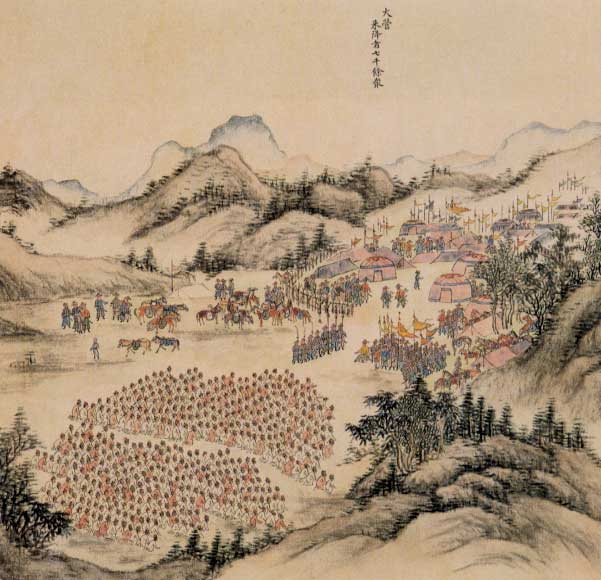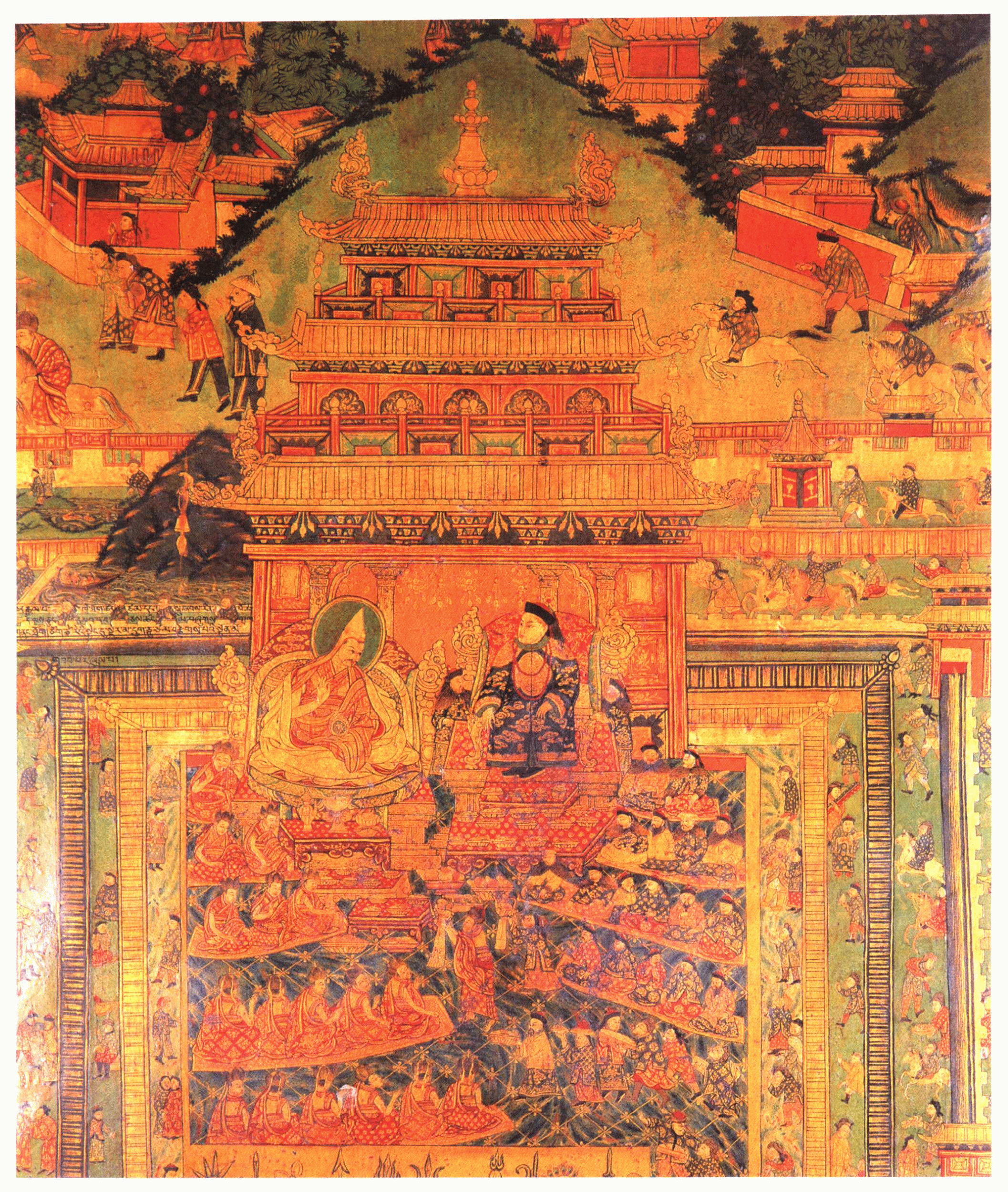|
Yue Zhongqi
Yue Zhongqi (岳鍾琪, 1686 – 1754) was a Chinese military commander of the Qing dynasty. He was a descendant of Yue Fei, and served as Ministry of War and Viceroy of Chuan-Shaan during the reign of the Yongzheng Emperor. Yue succeeded Nian Gengyao as Viceroy of Chuan-Shaan from 1725 to 1732. Zeng Jing, a ''xiucai'' in Hunan, sent his student Zhang Xi (張熙) to Xi'an in 1728, attempted to incite Yue to organize a plot to overthrow the Manchu-led Qing dynasty. Yue refused him and exposed his plot. Yue was commended by Yongzheng Emperor; Zeng Jing was easily caught and transported to Beijing. Qing Han Chinese general Yue Zhongqi interviewed the Tibetan collaborator with the Qing, Polhané Sönam Topgyé (P'o-lha-nas), concerning his involvement in crushing the Tibetan rebels, and sent a report to the Qing Yongzheng emperor on 17 August 1728. Yue also participated in the Dzungar–Qing Wars. He conquered Tibet and seized Lhasa with the 2,000 Green Standard soldiers and 1 ... [...More Info...] [...Related Items...] OR: [Wikipedia] [Google] [Baidu] |
Yue (surname)
Yuè is the Hanyu Pinyin transliteration of the Chinese family name 岳. In places which use the Wade-Giles romanization such as Taiwan, Yue is usually spelled as "Yüeh" or "Yueh". Yuè is also the pinyin transliteration of the surname 樂 in traditional character and 乐 in simplified character. This name can also be read as Lè, which has a different origin. Prominent individuals with the surname Yue 岳 * Yue Hua (岳華) actor *Yue Fei (岳飛) military general who lived in the Southern Song dynasty * Yue Xin (activist) (岳昕) feminist and Marxist activist Prominent individuals with the surname Yue 樂/乐 It is the 81st name on the ''Hundred Family Surnames'' poem.K. S. Tom. 989(1989). Echoes from Old China: Life, Legends and Lore of the Middle Kingdom. University of Hawaii Press. . *Yue Jin (樂進) Military General who served under Warlord Cao Cao in the Late Han Dynasty *Yue Yi Yue Yi (), enfeoffed as Lord of Changguo (), was a prominent military leader of the St ... [...More Info...] [...Related Items...] OR: [Wikipedia] [Google] [Baidu] |
Dzungar–Qing Wars
The Dzungar–Qing Wars ( mn, Зүүнгар-Чин улсын дайн, ) were a decades-long series of conflicts that pitted the Dzungar Khanate against the Qing dynasty and its Mongol vassals. Fighting took place over a wide swath of Inner Asia, from present-day central and eastern Mongolia to Tibet, Qinghai, and Xinjiang regions of present-day China. Qing victories ultimately led to the incorporation of Outer Mongolia, Tibet and Xinjiang into the Qing Empire that was to last until the fall of the dynasty in 1911–1912, and the genocide of much of the Dzungar population in the conquered areas. Background After the collapse of the Yuan dynasty in 1368, China's Mongol rulers withdrew to Mongolia and became known as the Northern Yuan dynasty. Over time, the Mongol state disintegrated into a series of Khanates, ruled by various descendants of Genghis Khan. The Qing dynasty defeated the Inner Chahar Mongol leader Ligdan Khan and annexed Inner Mongolia. While the Eastern Mo ... [...More Info...] [...Related Items...] OR: [Wikipedia] [Google] [Baidu] |
Qing Dynasty Generals
The Qing dynasty ( ), officially the Great Qing,, was a Manchu people, Manchu-led Dynasties in Chinese history, imperial dynasty of China and the last orthodox dynasty in Chinese history. It emerged from the Later Jin (1616–1636), Later Jin dynasty founded by the Jianzhou Jurchens, a Tungusic peoples, Tungusic-speaking ethnic group who Jurchen unification, unified other Jurchen tribes to form a new "Manchu" ethnic identity. The dynasty was officially proclaimed in 1636 in Manchuria (modern-day Northeast China and Outer Manchuria). It seized control of Beijing in 1644, then later expanded its rule over the whole of China proper and Taiwan under Qing rule, Taiwan, and finally Qing dynasty in Inner Asia, expanded into Inner Asia. The dynasty lasted until 1912 when it was overthrown in the 1911 Revolution, Xinhai Revolution. In orthodox Chinese historiography, the Qing dynasty was preceded by the Ming dynasty and succeeded by the Republic of China (1912–1949), Republic o ... [...More Info...] [...Related Items...] OR: [Wikipedia] [Google] [Baidu] |
1754 Deaths
Events January–March * January 28 – Horace Walpole, in a letter to Horace Mann, coins the word ''serendipity''. * February 22 – Expecting an attack by Portuguese-speaking militias in the Viceroyalty of the Río de la Plata, the indigenous Guarani people residing in the Misiones Orientales stage an attack on a small Brazilian Portuguese settlement on the Rio Pardo in what is now the Brazilian state of Rio Grande do Sul. The attack by 300 Guarani soldiers from the missions at San Luis, San Lorenzo and San Juan Bautista is repelled with a loss of 30 Guarani and is the opening of the Guarani War * February 25 – Guatemalan Sergeant Major Melchor de Mencos y Varón departs the city of Santiago de los Caballeros de Guatemala with an infantry battalion to fight British pirates that are reportedly disembarking on the coasts of Petén (modern-day Belize), and sacking the nearby towns. * March 16 – Ten days after the death of British Prime Minister Henry ... [...More Info...] [...Related Items...] OR: [Wikipedia] [Google] [Baidu] |
1686 Births
Events January–March * January 3 – In Madras (now Chennai) in India, local residents employed by the East India Company threaten to boycott their jobs after corporate administrator William Gyfford imposes a house tax on residences within the city walls. Gyfford places security forces at all entrances to the city and threatens to banish anyone who fails to pay their taxes, as well as to confiscate the goods of merchants who refuse to make sales. A compromise is reached the next day on the amount of the taxes. * January 17 – King Louis XIV of France reports the success of the Edict of Fontainebleau, issued on October 22 against the Protestant Huguenots, and reports that after less than three months, the vast majority of the Huguenot population had left the country. * January 29 – In Guatemala, Spanish Army Captain Melchor Rodríguez Mazariegos leads a campaign to conquer the indigenous Maya people in the rain forests of Lacandona, departing f ... [...More Info...] [...Related Items...] OR: [Wikipedia] [Google] [Baidu] |
Treason By The Book
''Treason by the Book'', by Jonathan Spence, is a historical account of the Zeng Jing (曾靜) case which took place during the reign of the Yongzheng Emperor of Qing China around 1730. Zeng Jing, a failed degree candidate heavily influenced by the seventeenth-century scholar Lü Liuliang, in October 1728 attempted to incite the descendant of Yue Fei, Yue Zhongqi (岳仲琪), Governor-general of Shaanxi-Sichuan, to rebellion. He gave a long list of accusations against Yongzheng, including the murder of the Kangxi Emperor and the killing of his brothers. This triggered a series of investigations which captured the attention of Yongzheng, who was eager to make his ascent to the throne seem legitimate. Highly concerned with the implications of the case, Yongzheng had Zeng Jing brought to Beijing for trial. But instead of imposing an immediate death sentence, the emperor began an intensive, written conversation with Zeng Jing. Zeng Jing eventually wrote a confession of error and receive ... [...More Info...] [...Related Items...] OR: [Wikipedia] [Google] [Baidu] |
Tibet Under Qing Rule
Tibet under Qing rule refers to the Qing dynasty's relationship with Tibet from 1720 to 1912. The political status of Tibet during this period has been the subject of political debate. The Qing called Tibet a ''fanbang'' or ''fanshu'', which has usually been translated as "vassal state." Chinese authorities referred to Tibet as a vassal state up until the 1950s and then as an "integral" part of China. The de facto independent Tibetan government (1912–1951) and Tibetan exiles promote the status of independent nation with only a "priest and patron" relationship between the Dalai Lama and the Qing emperor. Western historians such as Melvyn Goldstein, Elliot Sperling, and Jaques Gernet have described Tibet during the Qing period as a protectorate, vassal state, tributary, or something similar. By 1642, Güshi Khan of Khoshut Khanate had reunified Tibet under the spiritual and temporal authority of the 5th Dalai Lama of the Gelug school. In 1653, the Dalai Lama travelled on a sta ... [...More Info...] [...Related Items...] OR: [Wikipedia] [Google] [Baidu] |
Qing Dynasty In Inner Asia
The Qing dynasty in Inner Asia was the expansion of the Qing dynasty's realm in Inner Asia in the 17th and the 18th century AD, including both Inner Mongolia and Outer Mongolia, both Northeast China, Inner Manchuria and Outer Manchuria, Tibet, Qinghai and Xinjiang. Wars were fought primarily against the Northern Yuan, Northern Yuan dynasty (before 1636) and the Dzungar Khanate (1687–1758). Even before the conquest of China proper (see Transition from Ming to Qing), the Manchu people, Manchus had established the Later Jin (1616–1636), Later Jin dynasty that controlled Manchuria (modern Northeast China as well as Outer Manchuria) and Inner Mongolia, with the latter being previously controlled by the Northern Yuan dynasty under Ligdan Khan. After suppressing the Revolt of the Three Feudatories and the conquest of Taiwan under Qing rule, Taiwan as well as ending the Sino-Russian border conflicts in the 1680s, the Dzungar–Qing War broke out. This eventually led to Qing conquests ... [...More Info...] [...Related Items...] OR: [Wikipedia] [Google] [Baidu] |
Gyurme Namgyal
Gyurme Namgyal (; ) (died 11 November 1750) was a ruling prince of Tibet of the Pholha family. He was the son and successor of Polhané Sönam Topgyé and ruled from 1747 to 1750 during the period of Qing rule of Tibet. Gyurme Namgyal was murdered by the Manchu Ambans Fucin and Labdon in 1750. He was the last dynastic ruler of Tibet. After his death, in 1751, the Tibetan Ganden Phodrang government was taken over by the 7th Dalai Lama, Kelzang Gyatso. Thus began a new administrative order that would last for the next 150 years. Successor to the miwang Pholhané Gyurme Namgyal, also known as Dalai Batur, was the second son of the Tibetan ruling prince (miwang) Pholhané Sönam Topgyé who ruled from 1728 to 1747. The natural heir to the title was actually his eldest son Gyurme Yeshe Tseten, who had been given jurisdiction over Ngari (West Tibet) in 1729. Gyurme Yeshe Tseten had gathered good experience during the civil war in 1727–1728, and had administrative experience through his ... [...More Info...] [...Related Items...] OR: [Wikipedia] [Google] [Baidu] |
Jinchuan Campaigns
The Jinchuan campaigns (), also known as the Suppression of the Jinchuan Hill Peoples (Chinese: 平定兩金川), were two wars between Qing Empire and the rebel forces of Gyalrong chieftains ("Tusi") from the Jinchuan region. The first campaign against Chiefdom of Chuchen (Da Jinchuan or Greater Jinchuan in Chinese) happened in 1747 when the Tusi of Greater Jinchuan Slob Dpon attacked the Chiefdom of Chakla (Mingzheng). The Qianlong Emperor decided to mobilize forces and suppress Slob Dpon, who surrendered to the central government in 1749. The second campaign against Chiefdom of Tsanlha (Xiao Jinchuan or Lesser Jinchuan) took place in 1771, when the Jinchuan Tusi Sonom killed Gebushiza Tusi of Ngawa County in Sichuan Province. After Sonom killed Gebushiza Tusi, he helped Tusi of Lesser Jinchuan, Senge Sang, to occupy the lands belonging to the other Tusi in the region. The provincial government ordered Sonom to return lands and accept the trial at the Ministry of Justice immed ... [...More Info...] [...Related Items...] OR: [Wikipedia] [Google] [Baidu] |




